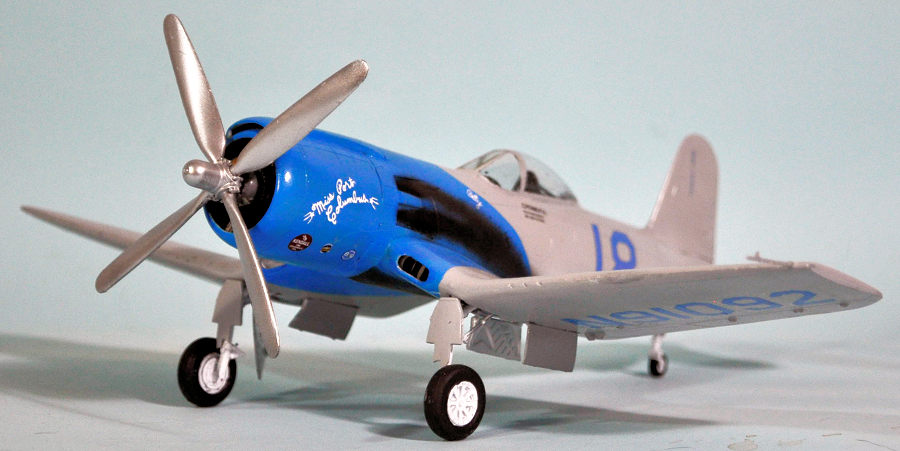
| KIT #: | 0409 |
| PRICE: | $30.00 'used' |
| DECALS: | One option |
| REVIEWER: | Tom Cleaver |
| NOTES: | Special Hobby kit. Czech Master cockpit. |

| HISTORY |
While many believe that the Goodyear F2G “Super” Corsair began life as the “answer” to the threat posed by the Kamikazes beginning in November 1944, such is not the case. Had Goodyear waited till then to begin developing such an airplane, it would never have been completed. In fact, the concept of such a “super” Corsair began in 1939, when Pratt & Whitney first proposed the R-4360 “Wasp Major” 28 cyliner four-row radial engine, which would provide an amazing 3,000 horsepower.
Once Pratt & Whitney had created the monster, Vought began work in 1942
to discover how to mate it to the Corsair. The development work was turned over
to Goodyear, which was manufacturing the Corsair under license as the FG-1. In
early 1944, long before there was any thought of suicide bombers attacking Navy
task forces, Goodyear took a standard FG-1A and mated it with the R-4360. The
big problem was cooling the engine; getting air back to that last row of
cylinders took a major effort in ducting inside the cowling and was never really
resolved until the introduction of a large “doghouse” downdraft intake that
could pressurize the air and get it back there. The engine provided a 50%
increase in power, and at low altitude the Corsair was capable of 431 m.p.h. at
16,000 feet, which was considerably faster than a standard Corsair at that
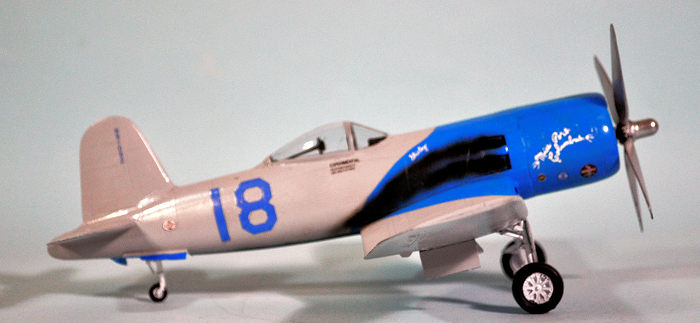 altitude. Further tests on F4U-1 BuNo 02460 and two FG-1s, BuNo 13471 and BuNo
13472, showed the aircraft capable of close to 400 m.p.h. below 5,000 feet, with
a climb rate of 7,000 feet per minute. Flown as an interceptor, the aircraft
could reach 34,000 feet in less than 5 minutes, which was twice the rate of
climb of the F4U-1A, and faster than the first of the new jets.
altitude. Further tests on F4U-1 BuNo 02460 and two FG-1s, BuNo 13471 and BuNo
13472, showed the aircraft capable of close to 400 m.p.h. below 5,000 feet, with
a climb rate of 7,000 feet per minute. Flown as an interceptor, the aircraft
could reach 34,000 feet in less than 5 minutes, which was twice the rate of
climb of the F4U-1A, and faster than the first of the new jets.
On the strength of these tests, the Navy ordered ten F2G-1 aircraft with non-folding wings and ten F2G-2s with folding wings and standard carrier equipment. Goodyear took the opportunity to cut down the rear fuselage and provide the pilot with one of the biggest and clearest bubble canopies of any wartime fighter.
When the threat of the Kamikazes appeared, the Navy finally broke down and brought the Corsair into the fleet, sending Marine F4U squadrons to the fast carriers to supplement the F6Fs that were the standard fleet defense fighter. Goodyear took the opportunity to press for full production of the F2G on the grounds it could provide high-speed low-altitude fleet defense against suicide bombers. The Navy, however, now had a better answer: Grumman had just come up with the F8F-1, which had stunned everyone at the Fighter Conference in October 1944, when it outflew everything there. Powered by the standard R-2800 which did not present the difficulties of the R-4360, the Bearcat was even faster at low altitude, not to mention being far more maneuverable than the F2G. Goodyear’s hopes for their fighter were for naught.
By August 1945, five F2G-1 and five F2G-2 aircraft had been completed, in addition to the five development aircraft that had begun life as FG-1s, two of which had been brought up to F2G standard as XF2G-1s. With the end of the war, the contract was canceled for the remaining airplanes. The F2Gs were transferred to the Naval Air Technical Center at NAS Patuxent, for further testing. With the advent of jets making any further development of piston-powered fighters redundant, the F2Gs were not flown much.
In 1946, the National Air Races came back. This time, rather than the purpose-built racers of the 1930s, the racers took advantage of the fact that surplus fighters like the P-51, the P-38, and the P-39 could be obtained for as little as $500. The 1946 race saw a clean sweep by ex-USAAF fighters.
 Cook Cleland, one of the great “personalities” of Naval Aviation during
World War II, had entered an FG-1 Corsair in the 1946 event, but it had been
outperformed by the P-39s. In 1947, Cleland was asked by his old friend, Fleet
Admiral William F. Halsey, what it would take for a Corsair to win. Cleland
replied that the Corsair was really a high-altitude performer, and suggested
that if there was a way for him to get hold of some of the F2Gs which were such
fantastic performers at low altitude, that a Corsair might win. Cleland didn’t
have to do a lot of convincing of Halsey that this would be good for Navy public
relations. Halsey arranged the paperwork, the F2Gs were declared surplus, and
Cook Cleland got hold of five of them, selling one XF2G-1 to Ron Puckett while
keeping the four F2G-2s.
Cook Cleland, one of the great “personalities” of Naval Aviation during
World War II, had entered an FG-1 Corsair in the 1946 event, but it had been
outperformed by the P-39s. In 1947, Cleland was asked by his old friend, Fleet
Admiral William F. Halsey, what it would take for a Corsair to win. Cleland
replied that the Corsair was really a high-altitude performer, and suggested
that if there was a way for him to get hold of some of the F2Gs which were such
fantastic performers at low altitude, that a Corsair might win. Cleland didn’t
have to do a lot of convincing of Halsey that this would be good for Navy public
relations. Halsey arranged the paperwork, the F2Gs were declared surplus, and
Cook Cleland got hold of five of them, selling one XF2G-1 to Ron Puckett while
keeping the four F2G-2s.
There wasn’t much time to do anything to the airplanes other than change the paint scheme. Cleland won the 1947 Thompson race in F2G #94, while his partner, Navy test pilot Deck Becker, took second place in F2G #74, which established them as the racers to beat. Puckett raced the XF2G-1 unmodified other than to paint over the Navy markings which were replaced with civilian registration and race number 18, and an orange cowling.
In 1948, both of Cleland’s F2Gs were highly modified, with enlarged intakes to provide air to the last row of cylinders, and the wings reduced in span. However, both were forced to drop out during the race due to engine backfiring that dislodged #74's air intake scoop in the third lap and #94's scoop in the fourth lap. Puckett’s XF2G-1 #18, now named “Miss Port Columbus” in honor of the Ohio city he came from, appeared in a new blue and gray paint scheme, with the wingtips clipped as had been done with FAA Corsairs, and the second rudder removed, reducing the vertical fin to the original size and height of standard Corsairs. The airplane also featured the same enlarged intake that Cleland used.
In 1949, Cleland returned with three F2Gs, while Ron Puckett returned
with #18, with its wingtips clipped again, outboard of the aileron. Cleland’s
#94 was even more modified, as was Becker’s #74, with the wings reduced in span
and end plates attached to control airflow. Ben McKillen would fly the F2G, #57,
which ori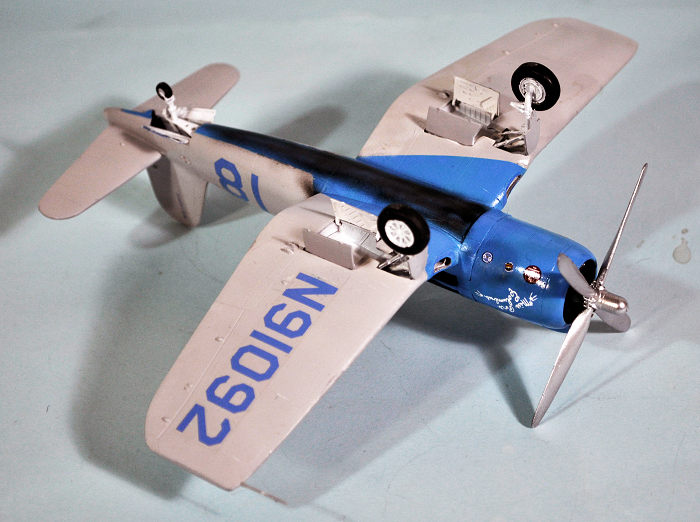 ginally was supposed to be used as a source of spare parts rather than
fly. Thus, it was not as radically modified as the other two, keeping the full
span wing. Puckett’s #18 featured wings reduced in span by removing the tips
outboard of the ailerons completely.
ginally was supposed to be used as a source of spare parts rather than
fly. Thus, it was not as radically modified as the other two, keeping the full
span wing. Puckett’s #18 featured wings reduced in span by removing the tips
outboard of the ailerons completely.
#74's gear reduction box stripped it gears just after Becker’s qualifying lap, forcing him to make an emergency landing and removing him from the line-up. On race day, the F2Gs made a clean sweep: Cleland took first place, winning the Thompson Trophy a second time, with Ron Puckett close behind in second place with “Miss Port Columbus,” while McKillen came in third in #57. McKillen went on to take First Place in the Tinnerman Race.
Unfortunately, the fatal crash of Bill Odom in his P-51 was the nail in the coffin for pylon air racing. Unlike the pre-war races where companies could test new engines and designers could see what happened with different airframes, the surplus wartime fighters were a technological dead-end. The aircraft companies that had sponsored teams like Cleland’s dropped out, which meant the 1949 Thompson Trophy Race was the end of the line until air racing picked up as “the world’s fastest motor sport” in Reno in 1964, where it is really just an exercise in nostalgia and entertainment by those with money to burn.
| THE KIT |
Outside of a vacuform conversion done by War Eagle to be used with the Otaki Corsair, and a resin conversion set done by Lone Star Models to convert the Tamiya Corsair, this kit by Special Hobby is the only 1/48 designed for the purpose kit of the F2G Corsair that has been produced. Aviation Usk did the airplane in 1/72, and there is a very good resin conversion set designed by Rodney Williams and produced by Obscureco to turn the 1/32 Revell Corsair into an F2G.
The kit includes two very clear and sharply molded vacuform canopies,
which is good because this is a model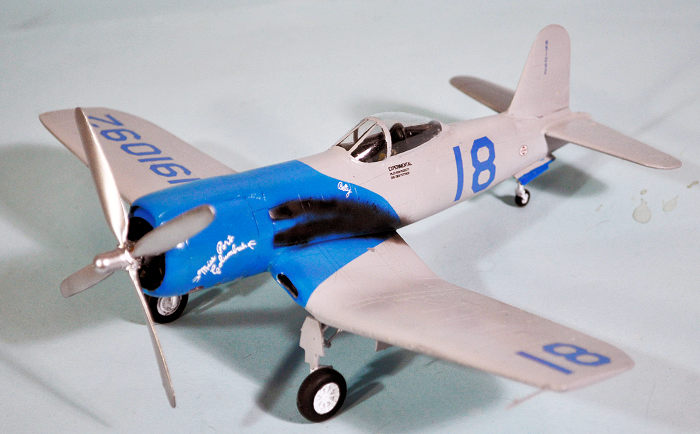 where preserving the beautiful lines of
the original means closing the canopy. With no visual distortion as might have
been the case with an injection molded canopy, this will allow the cockpit to be
seen with the canopy properly positioned.
where preserving the beautiful lines of
the original means closing the canopy. With no visual distortion as might have
been the case with an injection molded canopy, this will allow the cockpit to be
seen with the canopy properly positioned.
In its later iteration after the company was purchased out of bankruptcy, Accurate Miniatures released the Special Hobby kit as Ron Puckett’s “Mis Port Columbus.” This kit featured decals for the airplane as it appeared in 1947 and 1948. The kit differed from the “Race 57" kit in having injection plastic cockpit parts that were an approximation of the F4U-4 cockpit that all F2Gs were equipped with by Goodyear.
This particular kit was discovered lurking on the shelves of my LHS, in the Estate Sale section at a price far below the collector’s prices one sees on EvilBay. When I opened the kit to check it, I found a Czech Master resin F4U-4 cockpit inside. Since I can resist everything except temptation, and had a good experience with the kit when I did #57 a few years back, I grabbed it. The vacuformed canopies had been crushed, but the good folks at Special Hobby were happy to provide replacement; in fact, they sent me a set of six canopies, two of which were damaged in the mail, while the other four turned out to be exactly the number I would need to get one right. While waiting for the canopies, I also ordered the Obscureco resin one-piece cowling and the resin prop for the F2G.
| CONSTRUCTION |
I began by cutting off the vertical fin, then cutting off the lower extension for the second rudder, than reattaching it to the fuselage halves, filling in the cut and sanding it down. I took the opportunity to correctly offset the vertical fin to the left. At this point, I assembled the fuselage.
The resin engine, which has to be assembled from 28 separate cylinders, fit easily inside the Obscureco cowling. I painted the engine, attached it to the fuselage, and then slid the cowling over it. I sanded down all the seams after covering them with Mr. Surfacer.
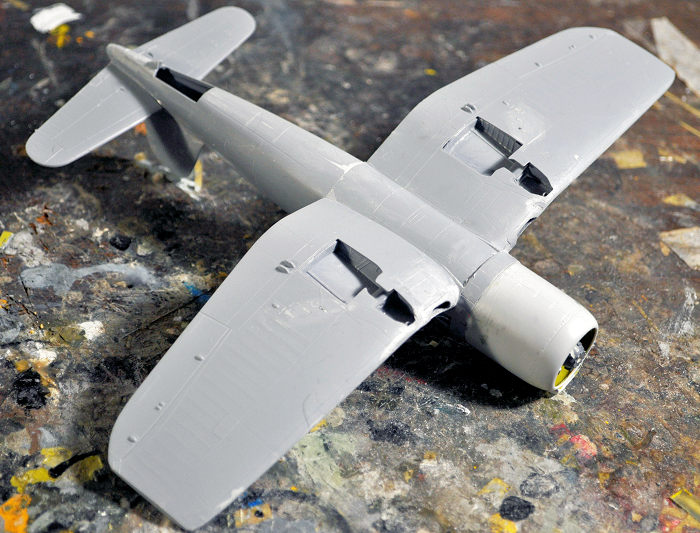 I then painted the resin cockpit black and painted the seat pad and seat
belts, then inserted the assembled cockpit in the completed fuselage.
I then painted the resin cockpit black and painted the seat pad and seat
belts, then inserted the assembled cockpit in the completed fuselage.
I then assembled the wing. The resin parts for the air intakes in the wing fit very nicely, while the walls for the wheel wells don’t. I sanded them down and got them to fit. I then attached the wing and horizontal stabilizers to the fuselage. I clipped the wingtips according to the instructions in the kit. After I had painted and decaled the model, I discovered from internet research that this was the 1948 configuration, when the airplane came in second in the race. If you want to do the final 1949 configuration, the wingtips need to be cut off completely outboard of the outer end of the ailerons.
I wanted to attach the canopy in one piece, since it is very clear and preserves the lines of the airplane. This wasn’t as easy as I thought; I managed to screw up two of the four canopies cutting them off the backing, then the third one was ruined getting it to attach correctly to the fuselage. Having learned from three errors, I managed to get #4 off the backing and trim it properly to fit right.
| COLORS & MARKINGS |
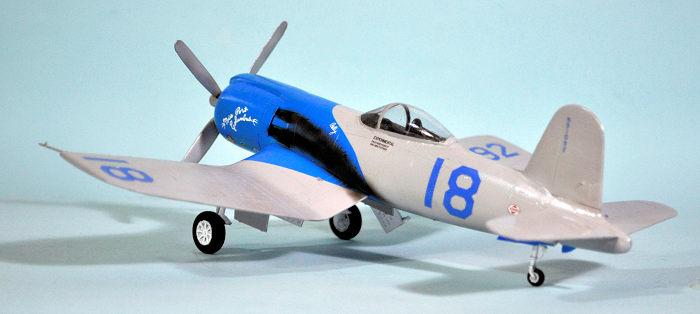 I painted the model overall in Tamiya Flat White XF-2,which I kept for
the wheel wells, then did the grey using Tamiya Sea Grey Medium XF-83. I then
masked off the fuselage and wing and painted the forward area with Tamiya X-14
Sky Blue, per the kit painting instructions. As it turns out, this isn’t exactly
the shade of the decal markings, but it is “close enough.” The prop was painted
with Tamiya Semi-gloss Black X-18, then Vallejo Aluminum.
I painted the model overall in Tamiya Flat White XF-2,which I kept for
the wheel wells, then did the grey using Tamiya Sea Grey Medium XF-83. I then
masked off the fuselage and wing and painted the forward area with Tamiya X-14
Sky Blue, per the kit painting instructions. As it turns out, this isn’t exactly
the shade of the decal markings, but it is “close enough.” The prop was painted
with Tamiya Semi-gloss Black X-18, then Vallejo Aluminum.
The kit decals went down without problem under a coat of Solvaset.
I gave the model an overall coat of Clear Satin varnish, then I applied exhaust staining per photos I found of the airplane after it raced, using Tamiya X-18 Semi-gloss Black thinned 50-50. I then attached the landing gear and prop, and unmasked the canopy.
| CONCLUSIONS |
The Special Hobby F2G kit is the only one out there in 1/48. For a limited-run kit, it offers fewer problems than what one might expect. The Obscureco cowling and intake, and prop, really help and are better than the kit parts. I highly recommend them. This Accurate Miniatures release is no longer in production, but if you shop around on the internet you can find it, though probably not for a price as cheap as I found - fortunately the guys at my LHS aren’t into “collector’s pricing.” This makes a nice companion to my “Sohio 57" racer, and if I found another one and could get the Draw Decals sheet, I might do a third as Cook Cleland’s highly modified 1949 winner. Recommended for Corsair fans with experience doing limited-run kits.
26 November 2020
Copyright ModelingMadness.com.
Review kit courtesy of my billfold. If you would like your product reviewed fairly and fairly quickly, please
contact
the editor or see other details in the
Note to
Contributors. Back to the Main Page
Back to the Review
Index Page
Back to the Previews Index Page